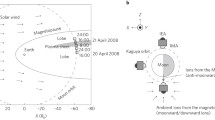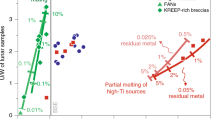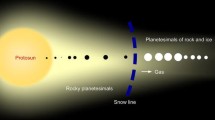Abstract
Lunar soil and certain meteorites contain noble gases trapped from the solar wind at various times in the past. The progress in the last decade to decipher these precious archives of solar history is reviewed. The samples appear to contain two solar noble gas components with different isotopic composition. The solar wind component resides very close to grain surfaces and its isotopic composition is identical to that of present-day solar wind. Experimental evidence seems by now overwhelming that somewhat deeper inside the grains there exists a second, isotopically heavier component. To explain the origin of this component remains a challenge, because it is much too abundant to be readily reconciled with the known present day flux of solar particles with energies above those of the solar wind. The isotopic composition of solar wind noble gases may have changed slightly over the past few Ga, but such a change is not firmly established. The upper limit of ~5% per Ga for a secular increase of the 3He/4He ratio sets stringent limits on the amount of He that may have been brought from the solar interior to the surface (cf. Bochsler, 1992). Relative abundances of He, Ne, and Ar in present-day solar wind are the same as the long term average recorded in metallic Fe grains in meteorites within error limits of some 15-20%. Xe, and to a lesser extent Kr, are enriched in the solar wind similar to elements with a first ionisation potential < 10 eV, although Kr and Xe have higher FIPs. This can be explained if the ionisation time governs the FIP effect (Geiss and Bochsler, 1986).
Similar content being viewed by others
References
Anders, E. and Grevesse, N.: 1989, ‘Abundances of the elements: meteoritic and solar', Geochim. Cosmochim. Acta 53, 197.
Becker, R. H., Schlutter, D. J., Rider, P. E., and Pepin, R. O.: 1998, ‘An acid-etch study of the Kapoeta achondrite: Implications for the argon-36/argon-38 ratio in the solar wind', Meteoritics Planet. Sci. 33, 109.
Benkert, J.-P., Baur, H., Signer, P., and Wieler, R.: 1993, ‘He, Ne, and Ar from the solar wind and solar energetic particles in lunar ilmenites and pyroxenes', J. Geophys. Res. (Planets) 98, 13147.
Black, D. C.: 1972, ‘On the origins of trapped helium, neon and argon isotopic variations in meteorites-I. Gas-rich meteorites, lunar soil and breccia', Geochim. Cosmochim. Acta 36, 347.
Bochsler, P.: 1984, ‘Helium and oxygen in the solar wind: dynamic properties and abundances of elements and helium isotopes as observed with the ISEE-3 plasma composition experiment', Habilitation Thesis, Univ. of Bern.
Bochsler, P.: 1992, ‘Minor ions — tracers for physical processes in the heliosphere', Solar Wind Seven, eds. E. Marsch and R. Schwenn, Pergamon, 323.
Bogard, D. D., Nyquist, L. E., Hirsch, W. C., and Moore, D. R.: 1973, ‘Trapped solar and cosmogenic noble gas abundances in Apollo 15 and 16 deep drill samples', Earth. Planet. Sci. Lett. 21, 52.
Cerutti, H.: 1974, ‘Die Bestimmung des Argons im Sonnenwind aus Messungen an den Apollo-SWC-Folien', PhD Thesis, Univ. of Bern.
Eberhardt, P., Geiss, J., Graf, H., Grögler, N., Krähenbühl, U., Schwaller, H., Schwarzmüller, J., and Stettler, A.: 1970, ‘Trapped solar wind noble gases, exposure age and K/Ar-age in Apollo 11 lunar fine material', Proc. Apollo 11 Lunar Sci. Conf., 1037.
Eberhardt, P., Geiss, J., and Grögler, N.: 1965, ‘Über die Verteilung der Uredelgase im Meteoriten Khor Temiki', Tschermaks Min. u. Petr. Mitt. 10, 535.
Etique, P., Signer, P., and Wieler, R.: 1981, ‘An in-depth study of neon and argon in lunar soil plagioclases, revisited: implanted solar flare noble gases', Lunar Planet. Sci. XII, Lunar Planet. Institute, Houston, 265.
Geiss, J.: 1973, ‘Solar wind composition and implications about the history of the solar system', Int. Cosmic Ray Conf. 13th, 3375.
Geiss, J.: 1998, ‘Solar wind abundance measurements: constraints on the FIP mechanism', Space Sci. Rev., this volume.
Geiss, J. and Bochsler, P.: 1986, ‘Solar wind composition and what we expect to learn from out-of-ecliptic measurements', In The sun and the heliosphere in three dimensions, ed. R. G. Marsden, Reidel, 173.
Geiss, J., Bühler, F., Cerutti, H., Eberhardt, P., and Filleux, C.: 1972, ‘Solar wind composition experiment', Apollo 16 Prelim. Sci. Rep., NASA SP-315, 14.1.
Geiss, J., Gloeckler, G., and von Steiger, R.: 1994, ‘Solar and heliospheric processes from solar wind composition measurements', Phil. Trans. R. Soc. London A 349, 213.
Goswami, J. N., Lal, D., and Wilkening, L. L.: 1984, ‘Gas-rich meteorites: probes for particle environment and dynamical processes in the inner solar system', Space Sci. Rev. 37, 111.
Hohenberg, C. M., Davis, P. K., Kaiser, W. A., Lewis, R. S., and Reynolds, J. H.: 1970, ‘Trapped and cosmogenic rare gases from stepwise heating of Apollo 11 samples', Proc. Apollo 11 Lunar Sci. Conf., 1283.
Kallenbach, R., et al.: 1998, ‘Fractionation of Si, Ne, and Mg isotopes in the solar wind as measured by SOHO/CELIAS/MTOF', Space Sci. Rev., this volume.
Kerridge, J. F.: 1980, ‘Secular variations in composition of the solar wind: Evidence and causes', Proc. Conf. Ancient Sun, eds. R. O. Pepin, J. A. Eddy, and R. B. Merrill, 475.
Manka, R. H. and Michel, F. C.: 1971, ‘Lunar atmosphere as a source of lunar surface elements', Proc. Lunar Sci. Conf. 2nd, 1717.
Marsch, E., von Steiger, R., and Bochsler, P.: 1995, ‘Element Fractionation by Diffusion in the Solar Chromosphere', Astron. Astrophys. 301, 261.
Mewaldt, R. A.: 1998, ‘Solar energetic particle studies of coronal isotopic composition', Space Sci. Rev., this volume.
Mewaldt, R. A., Spalding, J. D., and Stone, E. C.: 1984, ‘A high-resolution study of the isotopes of solar flare nuclei', Astrophys. J. 280, 892.
Meyer, J.-P.: 1985, ‘The baseline composition of solar energetic particles', Astrophys. J. 57Suppl., 151.
Murer, C. A., Baur, H., Signer, P., and Wieler, R.: 1997, ‘Helium, neon, and argon abundances in the solar wind: in vacuo etching of meteoritic iron nickel', Geochim. Cosmochim. Acta 61, 1303.
Pedroni, A.: 1989, ‘Die korpuskulare Bestrahlung der Oberflächen von Asteroiden; eine Studie der Edelgase in den Meteoriten Kapoeta und Fayetteville', PhD Thesis, (Nr. 8880), ETH Zürich.
Pedroni, A. and Begemann, F.: 1994, ‘On unfractionated solar noble gases in the H3–6 meteorite Acfer 111', Meteoritics 29, 632.
Pepin, R. O., Becker, R. H., and Rider, P. E.: 1995, ‘Xenon and krypton isotopes in extraterrestrial regolith soils and in the solar wind', Geochim. Cosmochim. Acta 59, 4997.
Pepin, R. O., Nyquist, L. E., Phinney, D., and Black, D. C.: 1970a, ‘Isotopic composition of rare gases in lunar samples', Science 167, 550.
Pepin, R. O., Nyquist, L. E., Phinney, D., and Black, D. C.: 1970b, ‘Rare gases in Apollo 11 lunar material', Proc. Apollo 11 Lunar Sci. Conf., 1435.
Peter, H.: 1998, ‘Element Separation in the Chromosphere', Space Sci. Rev., this volume.
Reynolds, J. H., Hohenberg, C. M., Lewis, R. S., Davis, P. K., and Kaiser, W. A.: 1970, ‘Isotopic analyses of rare gases from stepwise heating of lunar fines and rocks', Science 167, 545.
Sarda, P., Staudacher, T. and Allègre, C.J.: 1988, ‘Neon isotopes in submarine basalts', Earth Planet. Sci. Lett. 91, 73.
Selesnick, R. S., Cummings, A. C., Cummings, J. R., Leske, R. A., Mewaldt, R. A., and Stone, E. C.: 1993, ‘Coronal abundances of neon and magnesium isotopes from solar energetic particles', Astrophys. J. 418, L45.
Wänke, H.: 1965, ‘Der Sonnenwind als Quelle der Uredelgase in Steinmeteoriten', Z. Naturforsch. 20a, 946.
Wieler, R.: 1997, ‘Why are SEP noble gases so abundant in extraterrestrial samples?', Lunar and Planeary. Science. XXVIII, Lunar and Planetary Insitute, Houston, 1551.
Wieler, R. and Baur, H.: 1994, ‘Krypton and xenon from the solar wind and solar energetic particles in two lunar ilmenites of different antiquity', Meteoritics 29, 570.
Wieler, R. and Baur, H.: 1995, ‘Fractionation of Xe, Kr, and Ar in the solar corpuscular radiation deduced by closed system etching of lunar soils', Astrophys. J. 453, 987.
Wieler, R., Baur, H., and Signer, P.: 1986, ‘Noble gases from solar energetic particles revealed by closed system stepwise etching of lunar soil minerals', Geochim. Cosmochim. Acta 50, 1997.
Wieler, R., Kehm, K., Meshik, A. P., and Hohenberg, C. M.: 1996, ‘Secular changes in the xenon and krypton abundances in the solar wind recorded in single lunar grains', Nature 384, 46.
Ziegler, J. F.: 1985, ‘The stopping power and ranges of ions in solids', in The stopping and ranges of ions in matter, Vol. 1, Pergamon Press, New York.
Author information
Authors and Affiliations
Rights and permissions
About this article
Cite this article
Wieler, R. The Solar Noble Gas Record in Lunar Samples and Meteorites. Space Science Reviews 85, 303–314 (1998). https://doi.org/10.1023/A:1005166904225
Issue Date:
DOI: https://doi.org/10.1023/A:1005166904225




